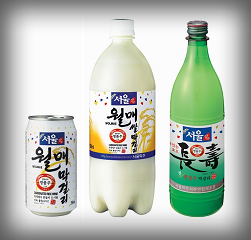Makkoli is a traditional alcoholic beverage native to Korea. It is referred to in English as Korean rice wine which is produced through fermenting a mixture of rice grains and boiled water. This combination gives off its milky, off-white color, and sweetness, resulting in about 6.5% to 7% alcohol by volume after its distillation process. It was originally quite popular among farmers in Korea, however, it has recently started to become more popular in cities, especially with the younger generations. Makkoli is popular and commonly consumed while eating pajeon, also known as Korean-style pancakes.
Commercially, makkoli is commonly available in plastic bottles or aseptic packaged containers. Traditionally, it is served in a large metal or wooden bowl from which individual cups and bowls are filled using a ladle. In popular restaurants or bars, makkoli can be also served in metallic kettles. As it is an unfiltered beverage, makkoli is generally shaken or stirred before consumed, as the cloudy white portion tends to settle to the bottom, leaving a pale yellow-clear liquid on top.
Fact: In Korea, makkoli is often used during ancestral memorial rites.
Recommended Restaurants & Bars
|
